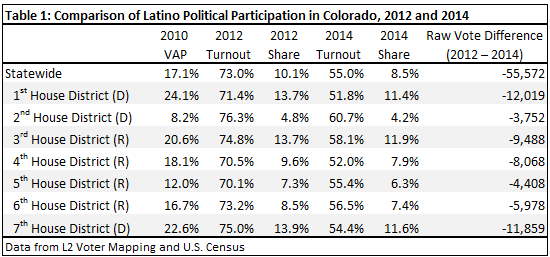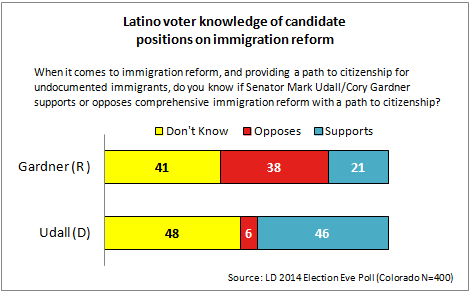In a recent article in the Los Angeles Times Mark Barabak examined the importance of the Mountain West, particularly Colorado, to Barack Obama’s 2008 and 2012 victories. Echoing many of the themes detailed in America’s New Swing Region, Barabak noted that the Democrats’ recent gains have served to shift a region that was long a Republican stronghold to one where the Democrats – in some contexts – can compete.
Most obviously, the region’s urbanization and changing demographics suggest an increasingly favorable environment for the Democrats in the long term. In the short term, however, the party has struggled to consistently translate these demographic advantages into votes.
In an earlier post, I examined these dynamics in Nevada by comparing Latino participation in the 2012 and 2014 elections to demonstrate how temperamental the state’s electorate can be and the degree to which the Democrats’ electoral success is dependent upon strong turnout among minority voters, particularly Latinos. Absent a high profile Democratic candidate able to access the resources needed to engage and mobilize Latino voters, many of these voters stayed home in 2014 (turnout among Nevada Latinos plummeted from 68% in 2012 to 31% in 2014) and the Republicans romped.
The 2014 context in Colorado, however, was very different from Nevada. Colorado was the only state with a Latino voting age population exceeding 10% and featuring competitive statewide races. Consistent with prior elections, Colorado Democrats did receive the bulk of votes cast by Latinos. Specifically, The Latino Decisions 2014 Election Eve Poll found that Democratic House, U.S. Senate, and gubernatorial candidates in Colorado won over 70% of the Latino vote.

However, as the data in Table 1 suggest, the Democrats left tens of thousands of Latino votes on the table. Specifically, these data compare the 2012 and 2014 Latino turnout rates both statewide and in Colorado’s seven House districts as reported by L2 Voter Mapping.[1] In total, over 55,000 Latinos who voted in 2012 did not participate in the 2014 election. As a consequence, Latino turnout declined from 73% in 2012 to 55% in 2014. Certainly, as compared to other states, turnout among Colorado Latinos was strong. In Colorado, however, where total turnout was 72%, the Latino share of the electorate decreased from 10% in 2012 to 8.6% in 2014 and Latinos accounted for over 22% of the decline in participation relative to 2012 despite constituting just 14% of total registrants.
More generally, the data presented in Table 1 indicate significant differences between the actual and potential share of the Latino electorate. Using the 2010 Latino voting age population (VAP) estimates from the U.S. Census as a benchmark, in both 2012 and 2014 Latinos constituted a significantly smaller portion of the electorate relative to the Latino share of the age eligible voting population in every House district. Thus, not only does Latino turnout lag relative to other ethnic and racial voting blocs in Colorado, many eligible Latinos are not even engaged in the political process.
Inspection of “The Latino Decisions 2014 Election Poll” suggests at least a partial explanation for this. Even among those Latinos who did vote, less than half think that the Democratic Party truly cares about their community and more Latinos voted to support their community than the Democratic Party. The poll also reveals the importance of immigration to Latino voters: 45% named immigration and the DREAM Act as their top issue and two-thirds said immigration was the most important or one of the most important issue affecting their decision to vote and their vote choice.

Yet, despite the centrality of immigration to the political participation of many Latinos, the Democratic Senate candidate, Mark Udall, failed to draw the type of contrast on immigration that can stimulate increased Latino turnout. Instead and as the data in Figure 1 indicate, 48% of Latinos were unaware of Udall’s support for comprehensive immigration and 41% did not know that Gardner opposed such legislation. Udall lost by less than 50,000 votes out of nearly two million that were cast.
To be clear, the results of the 2014 elections do not suggest that the Republicans are likely to increase their support among Latinos in Colorado any time soon. Just 24% of Latino voters in Colorado generally agree with the GOP on most issues, while 40% think that the Republican Party “has now become so anti-immigrant and anti-Latino that it would be hard for me to consider supporting them.” At the same time, despite obvious opportunities to do so, the Democrats did little to consolidate their standing among Colorado’s Latinos in 2014 and until they do, any Democratic gains in the region are likely to be ephemeral.
[1] The 2012 data only account for those who were registered in 2014.
David Damore is a Senior Analyst at Latino Decisions. He is Associate Professor of Political Science at the University of Nevada, Las Vegas, and a Senior Nonresident Fellow in the Brookings Institution’s Governance Studies Program.

